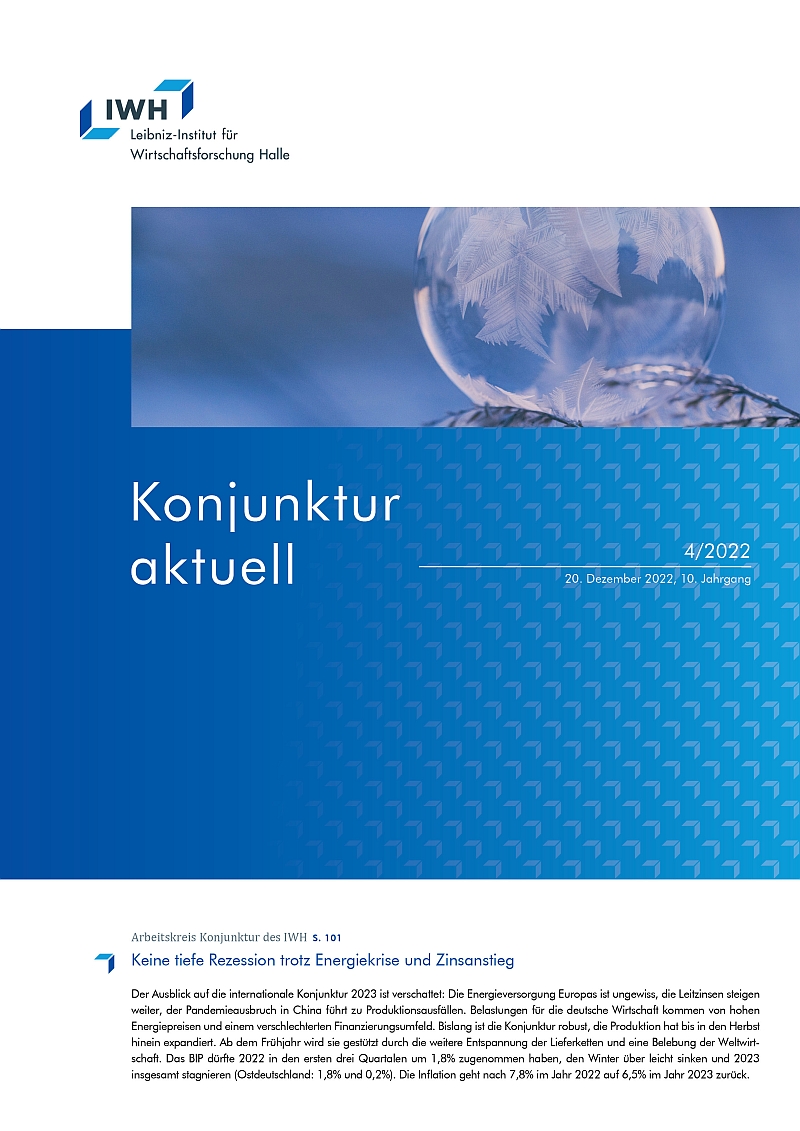Economic growth, public finances and greenhouse gas emissions in the medium term
Since autumn last year, the economic outlook in Germany has become somewhat brighter: Production and demand have so far remained largely stable despite the war and the energy crisis, natural gas prices have fallen significantly across Europe, and securing a gas supply that is independent of Russian sources seems to be well on its way. Although the influx of refugees from Ukraine is a financial burden in the short term, it holds opportunities in the medium term, because the natural decline of the population will slow down the expansion of the economy due to an increasing labour shortage. According to the current medium-term macroeconomic projection by the IWH, economic growth in the next six years will, with 1% per year, be about the same as in the past six years. General government net lending/borrowing will decrease to –1.1% relative to gross domestic product by 2027, which equals the structural net lending/borrowing given an almost closed output gap. The debt level will decline relative to GDP from 2024 onwards, not least because price dynamics will continue to be quite high for some time. Finally, the overall economic situation is an important determinant for greenhouse gas emissions. According to the IWH projections, the economic sectors with the highest emission shares in the medium term will remain “manufacturing”, “electricity, gas, steam and air conditioning” and “transport”. The emission intensity (the ratio of emissions to gross value added) decreases due to efficiency gains, especially in the energy supply sector, but hardly in transport. “If the efficiency gains in the release of greenhouse gases during production do not accelerate noticeably, emissions will continue to decline in the medium term, but much more slowly than necessary to achieve the national emission reduction targets,” says Oliver Holtemöller, head of the Department Macroeconomics and vice president at IWH.
Long version (in German)
Katja Heinisch, Oliver Holtemöller, Axel Lindner, Alessandro Sardone, Götz Zeddies: Wirtschaftswachstum, Staatsfinanzen und Treibhausgas-Emissionen in der mittleren Frist, in: IWH, Konjunktur aktuell, Jg. 10 (4), 2022, 146‒151. Halle (Saale) 2022.
Whom to contact
For Researchers

Vice President Department Head
If you have any further questions please contact me.
+49 345 7753-800 Request per E-MailFor Journalists

Press Officer
If you have any further questions please contact me.
+49 345 7753-765 Request per E-MailIWH list of experts
The IWH list of experts provides an overview of IWH research topics and the researchers and scientists in these areas. The relevant experts for the topics listed there can be reached for questions as usual through the IWH Press Office.
Related Publications

Wirtschaftswachstum, Staatsfinanzen und Treibhausgas-Emissionen in der mittleren Frist
in: Konjunktur aktuell, 4, 2022
Abstract
Die mittelfristige Projektion der gesamtwirtschaftlichen Lage in Deutschland beinhaltet, dass das Wirtschaftswachstum mit 1% pro Jahr in den kommenden sechs Jahren in etwa genauso hoch ausfällt wie in den vergangenen sechs Jahren. Der Staatshaushalt bleibt im Defizit, aber der Schuldenstand geht relativ zum Bruttoinlandsprodukt ab dem Jahr 2024 wieder zurück. Bei diesem Tempo der wirtschaftlichen Expansion werden die Emissionen mittelfristig zwar weiter zurückgehen, aber deutlich langsamer als nötig, um die nationalen Klimaschutzziele zu erreichen.



